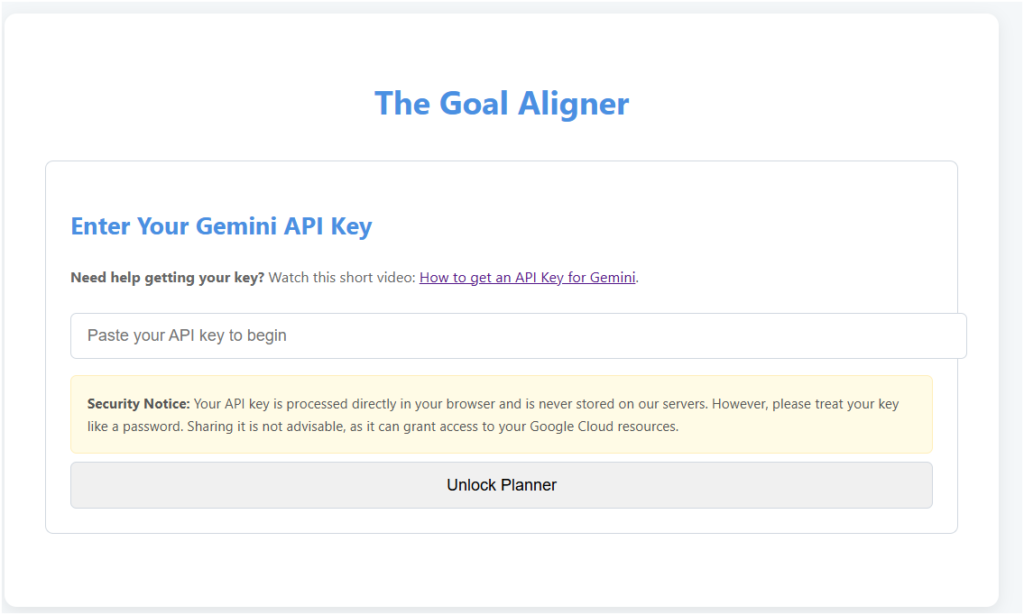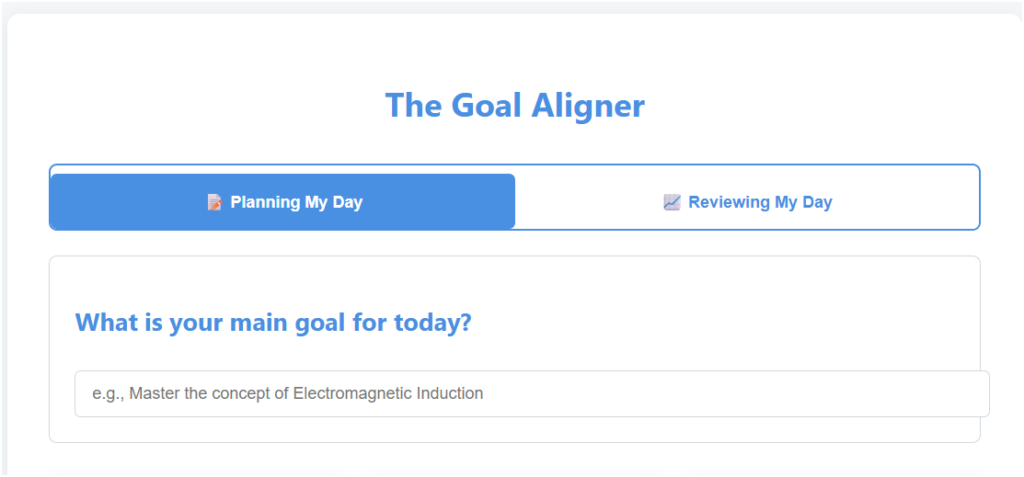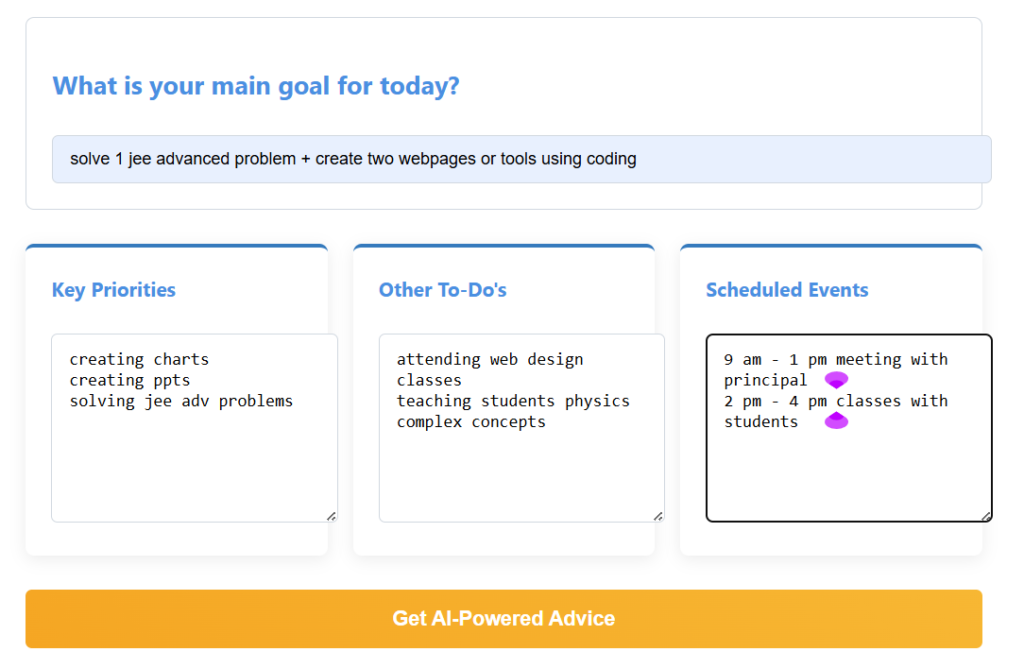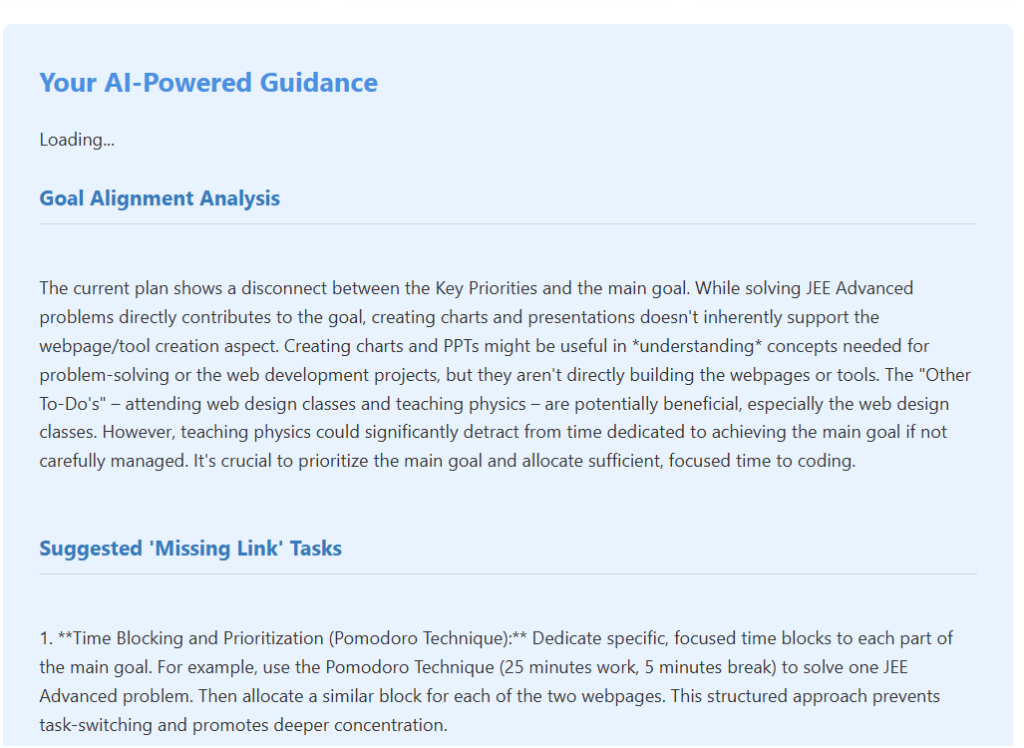In the rapidly evolving landscape of educational technology, the intersection of artificial intelligence and human-centered design has opened unprecedented possibilities for creating sophisticated learning tools. Today, I’m excited to share the architectural journey behind The Goal Aligner – a comprehensive daily planning and reflection application that demonstrates the power of vibe coding in educational software development.
Understanding the Core Architecture
The Goal Aligner represents a paradigm shift from traditional productivity tools by implementing evidence-based learning strategies through intelligent software design. At its foundation, the application operates on a dual-mode architecture that mirrors the cognitive processes of effective self-assessment and metacognitive reflection.
Module 1: Authentication and API Integration Layer
The application begins with a secure API key management system that serves as the gateway to AI-powered functionality. This module implements several critical design principles:
a. Security-First Approach: The system processes API keys directly in the browser without server-side storage, ensuring user privacy while maintaining functionality. The logic incorporates real-time validation to verify key authenticity before proceeding to core features.
b. Educational Transparency: Rather than hiding the technical requirements, the interface includes instructional resources (including video tutorials) to educate users about API key management, transforming a potential barrier into a learning opportunity.
c. Progressive Disclosure: The interface reveals functionality incrementally, preventing cognitive overload while building user confidence through successful completion of each step.

Module 2: Dual-Mode Planning Architecture
The heart of the application lies in its sophisticated mode-switching system that adapts the interface based on temporal context and user intent.
Planning Mode: Prospective Goal Alignment
The planning interface implements a three-card categorization system based on cognitive load theory and priority matrix principles:
a. Key Priorities Card: This module captures tasks directly aligned with the user’s stated goal, implementing the principle of goal-oriented task selection. The underlying logic emphasizes the connection between daily actions and long-term objectives.
b. Other To-Do’s Card: Recognizing that perfect goal alignment is unrealistic, this component acknowledges necessary but secondary tasks. The design psychology here prevents users from feeling guilty about non-goal-related activities while maintaining awareness of their impact.
c. Scheduled Events Card: This module accounts for fixed commitments, implementing time-blocking principles that help users visualize available capacity for goal-directed work.
Reviewing Mode: Retrospective Analysis
The reflection interface transforms the planning categories into analytical frameworks:
Activities Done Today: This component implements the reflection principles from learning science, encouraging users to evaluate completed work against their stated objectives.
Pending for Tomorrow: The continuation planning module helps users maintain momentum while preventing task accumulation that can lead to overwhelm.
Planned but Not Started: This critical component addresses the gap between intention and execution, providing data for the AI analysis engine to identify patterns and suggest improvements.

Module 3: AI-Powered Advisory Engine
The application’s intelligence layer represents the most sophisticated component, implementing advanced prompt engineering and contextual analysis.
Dynamic Prompt Generation
The system constructs contextually appropriate prompts based on the selected mode and user inputs. The logic differentiates between planning and reviewing scenarios, adjusting the AI’s analytical framework accordingly:
a. Planning Analysis: The prompt engineering focuses on goal alignment assessment, missing task identification, and strategic recommendations based on learning science principles like the Feynman Technique and deliberate practice.
b. Reviewing Analysis: The retrospective prompts emphasize pattern recognition, priority evaluation, and forward-looking guidance that builds on completed work while addressing gaps.
Intelligent Response Processing
The AI integration module processes natural language responses and formats them for optimal readability, implementing markdown parsing and structured presentation that enhances comprehension and actionability.

Module 4: Document Generation and Archival System
The PDF generation module represents a sophisticated implementation of the jsPDF library, creating professional reports that serve multiple purposes:
a. Content Capture Logic
The system temporarily modifies the DOM to hide interactive elements during capture, ensuring clean document generation while preserving all user inputs and AI-generated advice.
b. Watermarking and Branding
The document generation includes automated watermarking functionality that adds subtle branding while maintaining document professionalism. The implementation uses transparency layers and diagonal positioning for optimal visual impact without content interference.
c. Multi-Page Handling
The logic automatically manages page breaks and content flow, ensuring that long responses are properly formatted across multiple pages while maintaining readability and structure.

Module 5: User Experience and Interface Logic
The application implements several sophisticated UX patterns that enhance usability and engagement:
Progressive Enhancement
The interface reveals functionality incrementally, building user confidence through successful completion of each step. The logic prevents users from accessing advanced features until prerequisites are met.
State Management
The application maintains user context across mode switches and session interactions, implementing local state management that preserves user inputs while allowing seamless transitions between planning and reviewing modes.
Responsive Feedback Systems
Loading states, progress indicators, and success confirmations provide continuous feedback that keeps users informed about system status and builds confidence in the application’s reliability.
The Educational Philosophy in Code
What sets The Goal Aligner apart from generic productivity tools is its deep integration of educational principles throughout the technical architecture:
Metacognitive Scaffolding: The dual-mode structure forces users to engage in both prospective and retrospective thinking, building metacognitive skills through repeated practice.
Evidence-Based Recommendations: The AI prompts are specifically designed to suggest learning strategies validated by educational research, transforming productivity advice into pedagogically sound guidance.
Reflection-Action Cycles: The application structure mirrors the reflection-action cycles proven effective in educational settings, creating a tool that teaches while it organizes.
The Vibe Coding Revolution
Perhaps most remarkably, this entire sophisticated application was developed using vibe coding principles – the revolutionary approach where natural language descriptions guide AI to generate functional software.
The development process exemplified the transformative potential of vibe coding in educational technology:
- Rapid Iteration: Complex features like API integration and PDF generation were implemented through conversational AI collaboration rather than traditional programming
- Focus on Pedagogy: Development energy concentrated on educational effectiveness rather than syntax and technical implementation details
- Accessibility: The barrier between educational vision and technical reality was eliminated, allowing focus on learning design principles
- Natural Enhancement: Features evolved through natural language feedback loops, enabling continuous improvement based on educational insights rather than technical constraints
This project demonstrates that vibe coding isn’t just about faster development – it’s about democratizing the creation of sophisticated educational tools. When educators can transform pedagogical concepts into functional applications through natural language interaction, we unlock unprecedented possibilities for innovation in learning technology.
The Goal Aligner stands as proof that the future of educational technology lies not just in using AI, but in creating with AI. Through vibe coding, we can build tools that truly serve learning, designed by educators who understand the nuances of human development and goal achievement.
Experience The Goal Aligner yourself at: https://rathankar.com/wp-content/themes/newsmatic/The%20goal%20aligner.html
The intersection of vibe coding and educational design represents a new frontier in learning technology – one where pedagogical expertise drives innovation, and technical barriers no longer limit educational vision




